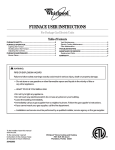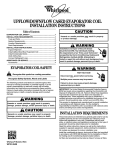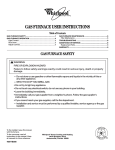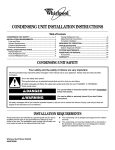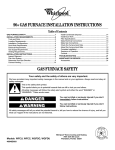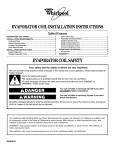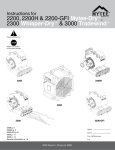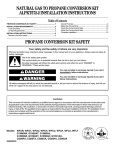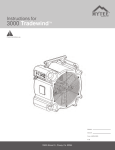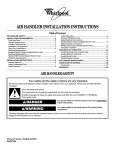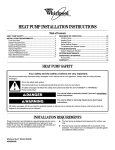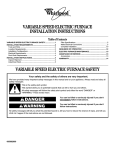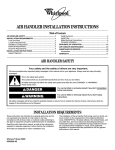Download GAS FURNACE USER INSTRUCTIONS
Transcript
GAS FURNACE USER INSTRUCTIONS Table of Contents GAS FURNACE SAFETY................................................................2 GAS FURNACE OPERATION ........................................................3 Lighting the Furnace ....................................................................3 Shutting Down the Furnace .........................................................3 Adjusting the Controls..................................................................3 GAS FURNACE MAINTENANCE...................................................4 Filter Maintenance........................................................................5 TROUBLESHOOTING ....................................................................6 ASSISTANCE OR SERVICE ...........................................................6 Replacement Parts.......................................................................6 WARRANTY ....................................................................................7 WARNING: FIRE OR EXPLOSION HAZARD Failure to follow safety warnings exactly could result in serious injury, death or property damage. — Do not store or use gasoline or other flammable vapors and liquids in the vicinity of this or any other appliance. — WHAT TO DO IF YOU SMELL GAS • Do not try to light any appliance. • Do not touch any electrical switch; do not use any phone in your building. • Leave the building immediately. • Immediately call your gas supplier from a neighbor’s phone. Follow the gas supplier’s instructions. • If you cannot reach your gas supplier, call the fire department. — Installation and service must be performed by a qualified installer, service agency or the gas supplier. To the installer: leave this manual with the furnace. To the consumer: read all instructions in this manual. Keep all manuals for future reference. 46877J002 Whirlpool® Home Cooling and Heating 7901 S.W. 6th Court Plantation, Florida 33324 GAS FURNACE SAFETY Your safety and the safety of others are very important. We have provided many important safety messages in this manual and on your appliance. Always read and obey all safety messages. This is the safety alert symbol. This symbol alerts you to potential hazards that can kill or hurt you and others. All safety messages will follow the safety alert symbol and either the word “DANGER” or “WARNING.” These words mean: You can be killed or seriously injured if you don't immediately follow instructions. You can be killed or seriously injured if you don't follow instructions. All safety messages will tell you what the potential hazard is, tell you how to reduce the chance of injury, and tell you what can happen if the instructions are not followed. IMPORTANT SAFETY INSTRUCTIONS ■ ■ ■ ■ ■ ■ The furnace area must be kept clear and free of combustible materials, gasoline, and other flammable vapors and liquids. Insulating materials may be combustible. A furnace installed in an attic or other insulated space must be kept free and clear of insulating materials. Examine the furnace when it is installed and also any time insulation is added. For proper and safe operation, the furnace needs air for combustion and ventilation. Do not block or obstruct air openings on the furnace, air openings to the area in which the furnace is installed, and the spacings around the furnace. This furnace is equipped with an ignition device which automatically lights the burners. See the “Gas Furnace Operation” section for information on lighting and shutting down the furnace. Should the gas supply fail to shut off or if overheating occurs, shut off the gas valve to the furnace before shutting off the electrical supply. Do not use the furnace if any part has been under water. A flood-damaged furnace is extremely dangerous. Attempts to use the furnace can result in fire or explosion. A qualified service agency should be contacted to inspect the furnace and to replace all gas controls, control system parts, electrical parts that have been wet, or the furnace if deemed necessary. ■ ■ Examine the furnace installation at least once a year to determine that: – All flue gas carrying areas external to the furnace, (i.e. chimney, vent connector) are clear and free of obstructions. – The vent connector is in place, slopes upward, and is physically sound without holes or excessive corrosion. – The return air duct connection(s) is physically sound, is sealed to the furnace casing, and terminates outside the space containing the furnace. – The physical support of the furnace is sound without sagging, cracks, gaps, etc. around the base so as to provide a seal between the support and the base. – There are no obvious signs of deterioration of the furnace. – The pilot and burner flames are in good adjustment. See the “Gas Furnace Maintenance” section. It is also recommended that the furnace should be inspected by a qualified person at least once per year. SAVE THESE INSTRUCTIONS 2 Gas Control Valve GAS FURNACE OPERATION Thermostat Control FA N 1 ON 70 50 80 TO AU 60 OFF ON 1 C1 3 C2 C3 4 1. Gas control switch 50 60 70 80 2 1. Selector switch 2. Room temperature 3. Fan switch 4. Heating & cooling temperature setting There are many types and styles of thermostats. Yours may look different from the one shown, depending on the type of thermostat and whether cooling was installed with the system. However, almost all thermostats perform the same basic functions. There are two switches located on the thermostat. One switch controls the heating and cooling (if applicable) functions. The other switch is for FAN operation, either continuous or automatic. Also on the thermostat is the temperature range for the desired heating and cooling temperatures. Lighting the Furnace 5. Push the gas control switch to ON. 6. Replace the burner compartment access panel (on some models). 7. Reconnect power. 8. Set the thermostat to the desired setting. 9. If the furnace will not operate, see “Shutting Down the Furnace” and call a qualified person. Shutting Down the Furnace 1. To shut down the furnace, set all the household thermostat control knobs to OFF or to the lowest setting (see Thermostat Control graphic). 2. Disconnect power. 3. Remove the burner compartment access panel (on some models). 4. Push the gas control switch to OFF. See “Gas Control Valve.” 5. Replace the burner compartment access panel (on some models). Adjusting the Controls To Turn the System On or Off ■ Move the selector switch to HEAT or COOL to turn the system on. ■ Move the selector switch to OFF to turn the system off. Explosion Hazard Furnace must be installed and serviced by a qualified person. Examples of a qualified person include: To Select the Temperature Move the thermostat dial or lever to select the temperature you would like the system to maintain. licensed heating personnel, authorized gas company personnel. Read and follow all instructions provided for installation, adjustment, service, alteration, or maintenance. Failure to follow these instructions can result in death, explosion, fire, or carbon monoxide poisoning. To Operate the Fan You may wish to increase your comfort by setting your system for continuous circulation of the indoor air. You may do this by moving the fan switch on the thermostat. ■ Move the fan switch to ON so the fan will operate continuously. ■ Move the fan switch to AUTO for the fan to operate only when the unit is either heating or cooling. 1. Set the house thermostat control(s) to the lowest setting. 2. Disconnect power. 3. Remove the burner compartment access panel (on some models). 4. This appliance is equipped with an automatic ignition device. Do not try to light the burners by hand. 3 GAS FURNACE MAINTENANCE IMPORTANT: It is recommended that the furnace be inspected and serviced at least once per year by a qualified person. Servicing should include the items covered in this section. Your gas furnace is designed to give many years of efficient, satisfactory service. There are routine maintenance steps you should take to keep your furnace operating efficiently. This maintenance will assure longer life, lower operating costs, and fewer service calls. In addition to the maintenance procedures listed in this manual, there are also other service and maintenance procedures that require the skills of a qualified person. ■ The flue gas passageways should be cleaned. ■ The gas burners should be cleaned. ■ The condensate flow should be checked. ■ The furnace ventilation system should be inspected and serviced. ■ Lubrication of the bearings in the circulating air blower motor and the combustion blower motor is not required. Explosion Hazard Furnace must be installed and serviced by a qualified person. Examples of a qualified person include: licensed heating personnel, authorized gas company personnel. Read and follow all instructions provided for installation, adjustment, service, alteration, or maintenance. Failure to follow these instructions can result in death, explosion, fire, or carbon monoxide poisoning. WARNING Explosion Hazard Use nonflammable cleaner. Failure to do so can result in death, explosion, or fire. Condensate Collection and Disposal System Maintenance If the furnace has a condensate drain, it is incorporated within the furnace and is self-priming. Check the condensate flow by shining a flashlight on the condensate drain. Look for water dripping from the discharge tube. If the condensate drain line becomes blocked or plugged, the furnace will not operate properly. If this occurs, the furnace should be inspected by a qualified person. Burner Flame IMPORTANT: Do not attempt to adjust the burner flame. While the furnace is in operation, observe the main burner flames. Compare these observations to “Typical Flame Appearance” to determine if proper flame adjustment is present. If your observations indicate improper flame adjustment, call a qualified person. Distorted flame or yellow tipping on natural gas flames, or long, yellow tips on propane flames, may be caused by lint or dirt accumulation, or obstructions over the main burner orifice. Dirt or lint can get inside the burner or burner ports, and into the air inlet between the burner and manifold pipe. Typical Flame Appearance 3 WARNING: 1 ELECTRICAL SHOCK HAZARD 2 Failure to follow safety warnings exactly could result in serious injury, death or property damage. 4 • Before servicing disconnect all electrical power to furnace. • When servicing controls label all wires prior to disconnecting. Reconnect wires correctly. • Verify proper operation after servicing. 4 1. Burner 2. Gas manifold 3. Heat exchanger 4. Burner flame (blue only) ■ Vent Maintenance IMPORTANT: ■ It is recommended that the furnace be inspected and serviced at least once a year by a qualified person. ■ Should the vent system become blocked at anytime, your furnace is equipped with a special safety control to prevent operation of the furnace until the condition has been corrected. If this occurs, contact a qualified person. ■ Keep the outside area where the vent terminates clear from any obstructions which might block or impede the venting of the furnace. Typical filter sizes are shown; however, any combination of filters whose area equals or exceeds the minimum area shown is satisfactory. Minimum Filter Requirements Chart Disposable Filters Cleanable Filters Airflow Size Qty. Min. Area Size Qty. Descriptor Min. Area (sq. in.) (in.) (sq. in.) (in.) 09 480 20 x 25 1 240 16 x 20 1 10 480 20 x 25 1 240 16 x 20 1 Filter Maintenance 12 576 16 x 20 2 288 16 x 20 1 Your furnace may use either a disposable filter or a cleanable filter. IMPORTANT: ■ Do not operate your furnace without a filter. A filter is required to protect the coil, blower, and internal parts from excessive dirt and dust. 14 672 20 x 20 2 336 20 x 20 1 16 768 20 x 20 2 384 20 x 20 1 20, 22 960 20 x 25 2 480 20 x 25 1 ■ The air filter should be inspected at least every 6 weeks and cleaned or replaced as required. NOTE: Dirty filters are the most common cause of inadequate heating or cooling performance and can sharply increase the operating costs of your unit. ■ When changing any furnace filter, it is important to measure the filter being replaced and to replace it with the same size and type of filter. ■ Install new/clean filters with the arrows on the side pointing in the direction of airflow. Filter Location The filter on your furnace will be located in one of several places on the unit, depending on which furnace style you own. See the sections following to determine where your filter is located. Filter Location - Upflow Models (Side Return) Replacing/Cleaning Filters Disposable Filter(s) If a disposable filter is used, replace with the same filter type and size. 3 Cleanable Filter(s) ■ ■ Cleanable filters may be replaced with disposable filters. See the Minimum Filter Requirements chart when selecting the proper size and quantity of disposable filters. To clean the filter, follow the filter manufacturer’s instructions. Minimum Filter Requirements ■ The Airflow Descriptor is the 2 digits immediately preceding the hyphen (-) in the furnace model number. Example 16 is the Airflow Descriptor for furnace model WFAT075B16-1A. The model number is located on the rating plate inside the access panel. ■ Areas and dimensions shown for cleanable filters are based on filters rated at 600 ft per minute face velocity. 1 2 1. Filter - slides in from front of unit 2. Filter rack 3. Return air duct If the filter is located in an external filter rack or cabinet on either side of the furnace cabinet, it may be easily removed, cleaned or changed, and reinserted in its proper location. 5 Filter Location - Upflow Models (Bottom Return) 1 2 3 4 1. Side 2. Base 3. Filter 4. Front If the furnace has a bottom return air, remove the lower front panel by lifting up and pulling out. The filter(s) may be removed by lifting up and sliding toward the front. Replace in a reverse procedure. Filter Location -Counterflow Models and Horizontal Models The filters in counterflow furnaces are typically placed by the installer into the return plenum of the furnace. TROUBLESHOOTING First try the solutions suggested here and possibly avoid the cost of a service call. Unit fails to operate ASSISTANCE OR SERVICE If you need further assistance, you can write to the below address with any questions or concerns: Whirlpool® Home Cooling and Heating 7901 Southwest 6th Street Plantation, FL 33324 Please include a daytime phone number in your correspondence. Replacement Parts To order replacement parts contact your Whirlpool® Home Cooling and Heating dealer. Gas Control Group ■ Manifold ■ Flame sensor ■ Burner ■ Gas valve/Ignition control ■ Orifice ■ Hot surface igniter Heat Exchanger Group ■ Primary heat exchanger ■ Secondary heat exchanger (if used) ■ Condensate drain pan (if used) Blower Group ■ Blower housing assembly ■ Blower motor mount ■ Blower wheel ■ Capacitor ■ Blower motor ■ Inducer blower Inducer Group ■ Check the following: Is the main switch that supplies power to the unit in the ON position? Has a fuse blown or has the circuit breaker tripped? If problem continues, call an electrician. Is the thermostat set properly? See “Adjusting the Controls.” Unit is operating but not providing complete comfort ■ Check the following: Is the thermostat set properly? See “Thermostat Control.” Is the filter clean? Replace or clean filter. See the “Filter Maintenance" section. Is the air able to circulate freely throughout your home? Do not block supply registers or return grilles with furniture or rugs. 6 ■ Pressure switch Electrical Group ■ Limit control ■ Rollout switch ■ Blower control ■ Auxiliary limit (if used) ■ Transformer ■ Blower door interlock switch 7 Keep this book and your sales slip together for future reference. You must provide proof of purchase or installation date for in-warranty service. Write down the following information about your furnace to better help you obtain assistance or service if you ever need it. You will need to know the complete model and serial number. You can find this information located on the rating plate on the inside panel for all models except for model WFCH, which is located on the outside of the product. Dealer name ____________________________________________________ Address ________________________________________________________ Phone number __________________________________________________ Model number __________________________________________________ Serial number __________________________________________________ Installation date ________________________________________________ 46877J002 © 2003. All rights reserved. ®/TM Whirlpool and all other trademarks are owned by Whirlpool, U.S.A., used under license by Tradewinds Distributing Company, LLC. 2/03 Printed in U.S.A.








